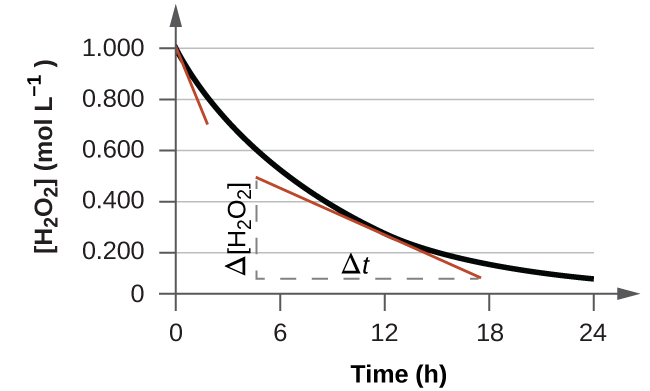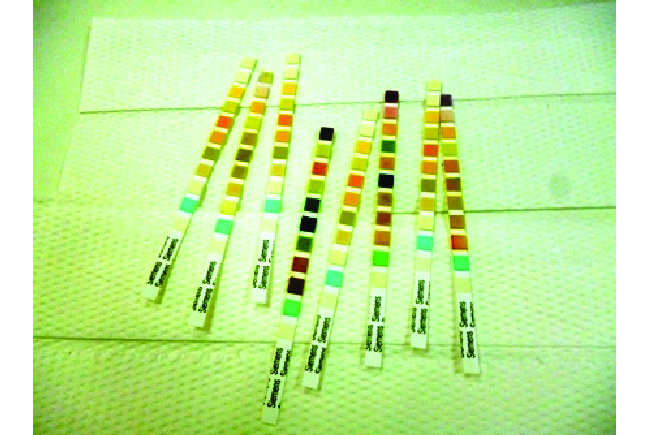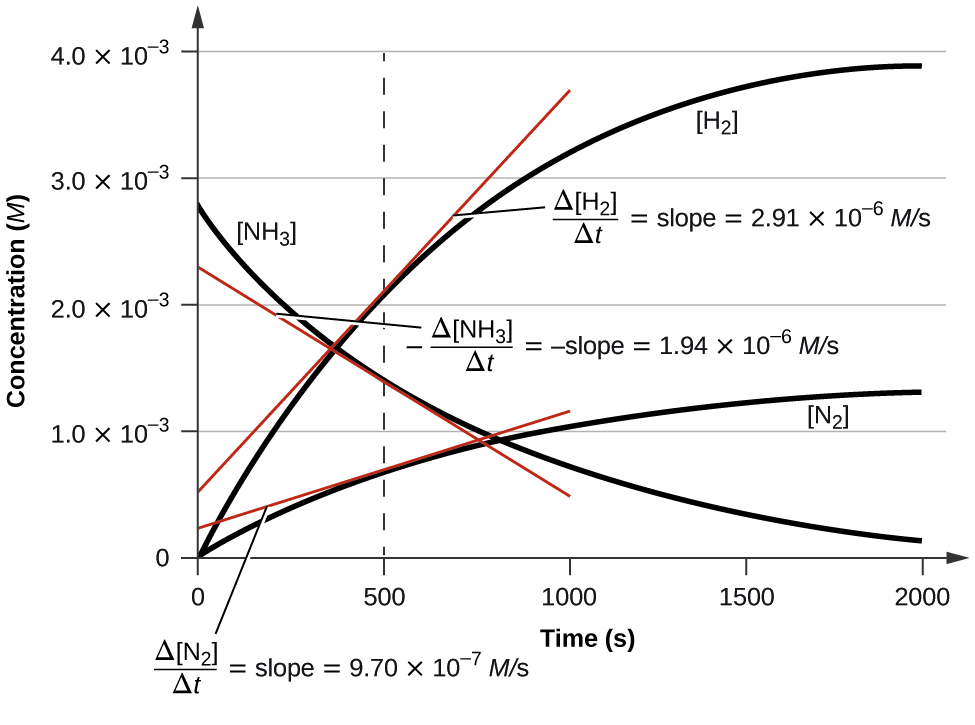Chapter 17 Reading Question 8 Part a What Would Be the Product of the Following Reaction?
Affiliate 12. Kinetics
12.one Chemical Reaction Rates
Learning Objectives
By the stop of this section, you volition exist able to:
- Ascertain chemical reaction charge per unit
- Derive rate expressions from the balanced equation for a given chemical reaction
- Calculate reaction rates from experimental data
A rate is a measure of how some property varies with time. Speed is a familiar rate that expresses the distance traveled past an object in a given corporeality of time. Wage is a charge per unit that represents the amount of money earned by a person working for a given corporeality of time. As well, the charge per unit of a chemical reaction is a measure out of how much reactant is consumed, or how much product is produced, past the reaction in a given corporeality of fourth dimension.
The rate of reaction is the change in the amount of a reactant or product per unit time. Reaction rates are therefore adamant by measuring the time dependence of some property that tin be related to reactant or production amounts. Rates of reactions that consume or produce gaseous substances, for instance, are conveniently determined past measuring changes in volume or force per unit area. For reactions involving 1 or more than colored substances, rates may exist monitored via measurements of light absorption. For reactions involving aqueous electrolytes, rates may be measured via changes in a solution'due south electrical conductivity.
For reactants and products in solution, their relative amounts (concentrations) are conveniently used for purposes of expressing reaction rates. If we measure the concentration of hydrogen peroxide, H2O2, in an aqueous solution, we find that it changes slowly over fourth dimension every bit the H2O2 decomposes, according to the equation:
[latex]2\text{H}_2\text{O}_2(aq)\;{\longrightarrow}\;2\text{H}_2\text{O}(l)\;+\;\text{O}_2(g)[/latex]
The rate at which the hydrogen peroxide decomposes can exist expressed in terms of the charge per unit of change of its concentration, as shown here:
[latex]\begin{array}{r @{{}={}} l} \text{charge per unit\;of\;decomposition\;of\;H}_2\text{O}_2 & - \frac{\text{change\;in\;concentration\;of\;reactant}}{\text{fourth dimension\;interval}} \\[0.5em] & - \frac{[\text{H}_2\text{O}_2]_{t_2}\;-\;[\text{H}_2\text{O}_2]_{t_1}}{t_2\;-\;t_1} \\[0.5em] & - \frac{{\Delta}[\text{H}_2\text{O}_2]}{{\Delta}t} \end{array}[/latex]
This mathematical representation of the change in species concentration over time is the rate expression for the reaction. The brackets indicate molar concentrations, and the symbol delta (Δ) indicates "change in." Thus, [latex][\text{H}_2\text{O}_2]_{t_1}[/latex] represents the tooth concentration of hydrogen peroxide at some fourth dimension t 1; likewise,[latex][\text{H}_2\text{O}_2]_{t_2}[/latex] represents the molar concentration of hydrogen peroxide at a afterwards time t ii; and Δ[HtwoO2] represents the change in molar concentration of hydrogen peroxide during the time interval Δt (that is, t two − t one). Since the reactant concentration decreases as the reaction gain, Δ[H2O2] is a negative quantity; nosotros place a negative sign in front end of the expression because reaction rates are, by convention, positive quantities. Effigy 1 provides an example of data collected during the decomposition of H2O2.

To obtain the tabulated results for this decomposition, the concentration of hydrogen peroxide was measured every 6 hours over the form of a twenty-four hour period at a constant temperature of 40 °C. Reaction rates were computed for each fourth dimension interval by dividing the alter in concentration past the respective time increase, as shown here for the first 6-hour period:
[latex]\frac{-{\Delta}[\text{H}_2\text{O}_2]}{{\Delta}t} = \frac{-(0.500\;\text{mol/L}\;-\;1.000\;\text{mol/50})}{(half dozen.00\;\text{h}\;-\;0.00\;\text{h})} = 0.0833\;\text{mol\;L}^{-1}\text{h}^{-one}[/latex]
Notice that the reaction rates vary with time, decreasing equally the reaction gain. Results for the last 6-hr period yield a reaction rate of:
[latex]\frac{-{\Delta}[\text{H}_2\text{O}_2]}{{\Delta}t} = \frac{-(0.0625\;\text{mol/50}\;-\;0.125\;\text{mol/L})}{(24.00\;\text{h}\;-\;xviii.00\;\text{h})} = 0.0104\;\text{mol\;L}^{-1}\text{h}^{-1}[/latex]
This behavior indicates the reaction continually slows with time. Using the concentrations at the beginning and end of a fourth dimension period over which the reaction rate is changing results in the calculation of an average rate for the reaction over this time interval. At any specific time, the rate at which a reaction is proceeding is known as its instantaneous charge per unit. The instantaneous rate of a reaction at "time naught," when the reaction commences, is its initial rate. Consider the illustration of a automobile slowing down as it approaches a stop sign. The vehicle'southward initial charge per unit—coordinating to the beginning of a chemic reaction—would be the speedometer reading at the moment the driver begins pressing the brakes (t 0). A few moments later, the instantaneous rate at a specific moment—call it t 1—would be somewhat slower, equally indicated by the speedometer reading at that point in time. As fourth dimension passes, the instantaneous rate volition continue to fall until information technology reaches zero, when the machine (or reaction) stops. Unlike instantaneous speed, the car's boilerplate speed is not indicated by the speedometer; but it tin be calculated as the ratio of the distance traveled to the fourth dimension required to bring the vehicle to a complete terminate (Δt). Similar the decelerating car, the boilerplate rate of a chemical reaction volition autumn somewhere between its initial and final rates.
The instantaneous rate of a reaction may be determined i of two ways. If experimental weather permit the measurement of concentration changes over very short time intervals, then average rates computed as described earlier provide reasonably expert approximations of instantaneous rates. Alternatively, a graphical procedure may exist used that, in effect, yields the results that would exist obtained if brusk fourth dimension interval measurements were possible. If nosotros plot the concentration of hydrogen peroxide against fourth dimension, the instantaneous rate of decomposition of HiiO2 at whatever time t is given by the slope of a direct line that is tangent to the curve at that time (Figure 2). We can use calculus to evaluating the slopes of such tangent lines, just the procedure for doing then is beyond the scope of this chapter.

Reaction Rates in Analysis: Examination Strips for Urinalysis
Physicians oftentimes use dispensable test strips to measure the amounts of various substances in a patient's urine (Effigy 3). These test strips contain various chemic reagents, embedded in small pads at various locations along the strip, which undergo changes in colour upon exposure to sufficient concentrations of specific substances. The usage instructions for test strips often stress that proper read time is disquisitional for optimal results. This emphasis on read time suggests that kinetic aspects of the chemical reactions occurring on the test strip are important considerations.
The test for urinary glucose relies on a 2-step process represented past the chemical equations shown here:
[latex]\text{C}_6\text{H}_{12}\text{O}_6\;+\;\text{O}_2\;{\xrightarrow[\text{catalyst}]{}}\;\text{C}_6\text{H}_{10}\text{O}_6\;+\;\text{H}_2\text{O}_2[/latex]
[latex]2\text{H}_2\text{O}_2\;+\;two\text{I}^{-}\;{\xrightarrow[\text{catalyst}]{}}\;\text{I}_2\;+\;2\text{H}_2\text{O}\;+\;\text{O}_2[/latex]
The first equation depicts the oxidation of glucose in the urine to yield glucolactone and hydrogen peroxide. The hydrogen peroxide produced subsequently oxidizes colorless iodide ion to yield brown iodine, which may be visually detected. Some strips include an additional substance that reacts with iodine to produce a more than distinct color modify.
The two test reactions shown in a higher place are inherently very boring, merely their rates are increased past special enzymes embedded in the test strip pad. This is an instance of catalysis, a topic discussed later in this chapter. A typical glucose test strip for use with urine requires approximately 30 seconds for completion of the color-forming reactions. Reading the result too soon might atomic number 82 one to conclude that the glucose concentration of the urine sample is lower than information technology really is (a faux-negative upshot). Waiting too long to assess the colour change can lead to a false positive due to the slower (not catalyzed) oxidation of iodide ion by other substances found in urine.

Relative Rates of Reaction
The rate of a reaction may be expressed in terms of the change in the amount of any reactant or product, and may be simply derived from the stoichiometry of the reaction. Consider the reaction represented by the following equation:
[latex]2\text{NH}_3(g)\;{\longrightarrow}\;\text{N}_2(g)\;+\;3\text{H}_2(g)[/latex]
The stoichiometric factors derived from this equation may exist used to chronicle reaction rates in the aforementioned mode that they are used to related reactant and production amounts. The relation between the reaction rates expressed in terms of nitrogen production and ammonia consumption, for instance, is:
[latex]-\;\frac{{\Delta}\text{mol\;NH}_3}{{\Delta}t}\;\times\;\frac{1\;\text{mol\;North}_2}{2\;\text{mol\;NH}_3} = \frac{{\Delta}\text{mol\;N}_2}{{\Delta}t}[/latex]
We can express this more than merely without showing the stoichiometric gene's units:
[latex]-\;\frac{1}{2}\;\frac{{\Delta}\text{mol\;NH}_3}{{\Delta}t} = \frac{{\Delta}\text{mol\;N}_2}{{\Delta}t}[/latex]
Note that a negative sign has been added to account for the opposite signs of the two amount changes (the reactant amount is decreasing while the product corporeality is increasing). If the reactants and products are present in the same solution, the molar amounts may be replaced by concentrations:
[latex]-\;\frac{i}{two}\;\frac{{\Delta}[\text{NH}_3]}{{\Delta}t} = \frac{{\Delta}[\text{N}_2]}{{\Delta}t}[/latex]
Similarly, the charge per unit of formation of Hii is three times the rate of formation of Due north2 considering three moles of H2 course during the time required for the germination of 1 mole of N2:
[latex]\frac{1}{3}\;\frac{{\Delta}[\text{H}_2]}{{\Delta}t} = \frac{{\Delta}[\text{Northward}_2]}{{\Delta}t}[/latex]
Figure 4 illustrates the modify in concentrations over time for the decomposition of ammonia into nitrogen and hydrogen at 1100 °C. We tin can see from the slopes of the tangents drawn at t = 500 seconds that the instantaneous rates of change in the concentrations of the reactants and products are related by their stoichiometric factors. The rate of hydrogen product, for example, is observed to be three times greater than that for nitrogen production:
[latex]\frac{two.91\;\times\;ten^{-vi}\;M/\text{s}}{9.71\;\times\;10^{-half-dozen}\;Yard/\text{south}}\;{\approx}\;3[/latex]

Example 1
Expressions for Relative Reaction Rates
The outset step in the production of nitric acid is the combustion of ammonia:
[latex]4\text{NH}_3(one thousand)\;+\;5\text{O}_2(chiliad)\;{\longrightarrow}\;4\text{NO}(g)\;+\;6\text{H}_2\text{O}(one thousand)[/latex]
Write the equations that relate the rates of consumption of the reactants and the rates of germination of the products.
Solution
Considering the stoichiometry of this homogeneous reaction, the rates for the consumption of reactants and germination of products are:
[latex]-\frac{1}{4}\;\frac{{\Delta}[\text{NH}_3]}{{\Delta}t} = -\frac{1}{5}\;\frac{{\Delta}[\text{O}_2]}{{\Delta}t} = \frac{1}{4}\;\frac{{\Delta}[\text{NO}]}{{\Delta}t} = \frac{ane}{half-dozen}\;\frac{{\Delta}[\text{H}_2\text{O}]}{{\Delta}t}[/latex]
Check Your Learning
The rate of germination of Brii is 6.0 × 10−6 mol/Fifty/south in a reaction described past the following net ionic equation:
[latex]five\text{Br}^{-}\;+\;\text{BrO}_3^{\;\;-}\;+\;6\text{H}^{+}\;{\longrightarrow}\;iii\text{Br}_2\;+\;3\text{H}_2\text{O}[/latex]
Write the equations that relate the rates of consumption of the reactants and the rates of formation of the products.
Answer:
[latex]-\frac{1}{v}\;\frac{{\Delta}[\text{Br}^{-}]}{{\Delta}t} = -\frac{{\Delta}[\text{BrO}_3^{\;\;-}]}{{\Delta}t} = -\frac{one}{6}\;\frac{{\Delta}[\text{H}^{+}]}{{\Delta}t} = \frac{i}{iii}\;\frac{{\Delta}[\text{Br}_2]}{{\Delta}t} = \frac{1}{3}\;\frac{{\Delta}[\text{H}_2\text{O}]}{{\Delta}t}[/latex]
Example two
Reaction Rate Expressions for Decomposition of HiiO2
The graph in Figure two shows the charge per unit of the decomposition of H2O2 over time:
[latex]2\text{H}_2\text{O}_2\;{\longrightarrow}\;ii\text{H}_2\text{O}\;+\;\text{O}_2[/latex]
Based on these data, the instantaneous rate of decomposition of HtwoO2 at t = 11.1 h is determined to be
three.20 × ten−two mol/L/h, that is:
[latex]-\frac{{\Delta}[\text{H}_2\text{O}_2]}{{\Delta}t} = 3.20\;\times\;x^{-two}\;\text{mol\;L}^{-i}\text{h}^{-i}[/latex]
What is the instantaneous rate of production of HtwoO and Oii?
Solution
Using the stoichiometry of the reaction, we may determine that:
[latex]-\frac{1}{ii}\;\frac{{\Delta}[\text{H}_2\text{O}_2]}{{\Delta}t} = \frac{1}{2}\;\frac{{\Delta}[\text{H}_2\text{O}]}{{\Delta}t} = \frac{{\Delta}[\text{O}_2]}{{\Delta}t}[/latex]
Therefore:
[latex]\frac{1}{2}\;\times\;3.20\;\times\;10^{-ii}\;\text{mol\;Fifty}^{-ane}\text{h}^{-one} = \frac{{\Delta}[\text{O}_2]}{{\Delta}t}[/latex]
and
[latex]\frac{{\Delta}[\text{O}_2]}{{\Delta}t} = 1.60\;\times\;10^{-2}\;\text{mol\;L}^{-ane}\text{h}^{-1}[/latex]
Check Your Learning
If the rate of decomposition of ammonia, NH3, at 1150 K is 2.x × ten−six mol/L/south, what is the charge per unit of product of nitrogen and hydrogen?
Answer:
1.05 × 10−6 mol/L/due south, North2 and three.15 × x−6 mol/50/southward, Hii.
Key Concepts and Summary
The charge per unit of a reaction can be expressed either in terms of the decrease in the amount of a reactant or the increase in the amount of a production per unit of measurement fourth dimension. Relations betwixt different rate expressions for a given reaction are derived directly from the stoichiometric coefficients of the equation representing the reaction.
Primal Equations
- relative reaction rates for [latex]a\text{A}\;{\longrightarrow}\;b\text{B} = -\frac{1}{a}\;\frac{{\Delta}[\text{A}]}{{\Delta}t} = \frac{one}{b}\;\frac{{\Delta}[\text{B}]}{{\Delta}t}[/latex]
Chemistry End of Chapter Exercises
- What is the difference between average rate, initial rate, and instantaneous rate?
- Ozone decomposes to oxygen co-ordinate to the equation [latex]2\text{O}_3(chiliad)\;{\longrightarrow}\;iii\text{O}_2(yard)[/latex]. Write the equation that relates the rate expressions for this reaction in terms of the disappearance of O3 and the formation of oxygen.
- In the nuclear industry, chlorine trifluoride is used to set uranium hexafluoride, a volatile chemical compound of uranium used in the separation of uranium isotopes. Chlorine trifluoride is prepared past the reaction [latex]\text{Cl}_2(g)\;+\;3\text{F}_2(one thousand)\;{\longrightarrow}\;ii\text{ClF}_3(g)[/latex]. Write the equation that relates the rate expressions for this reaction in terms of the disappearance of Cl2 and F2 and the germination of ClF3.
- A study of the rate of dimerization of C4H6 gave the data shown in the tabular array:
[latex]two\text{C}_4\text{H}_6\;{\longrightarrow}\;\text{C}_8\text{H}_{12}[/latex]Fourth dimension (s) 0 1600 3200 4800 6200 [C4Hhalf dozen] (M) 1.00 × ten−2 5.04 × ten−3 three.37 × ten−3 2.53 × ten−3 ii.08 × ten−3 Tabular array ane. (a) Make up one's mind the boilerplate rate of dimerization between 0 southward and 1600 south, and between 1600 south and 3200 southward.
(b) Guess the instantaneous rate of dimerization at 3200 southward from a graph of time versus [C4Hhalf-dozen]. What are the units of this rate?
(c) Determine the boilerplate rate of formation of C8H12 at 1600 s and the instantaneous rate of germination at 3200 s from the rates constitute in parts (a) and (b).
- A written report of the rate of the reaction represented as [latex]2A\;{\longrightarrow}\;B[/latex] gave the following data:
Time (south) 0.0 5.0 10.0 15.0 twenty.0 25.0 35.0 [A] (M) i.00 0.952 0.625 0.465 0.370 0.308 0.230 Table 2. (a) Decide the boilerplate charge per unit of disappearance of A between 0.0 s and 10.0 s, and between x.0 s and 20.0 south.
(b) Estimate the instantaneous charge per unit of disappearance of A at 15.0 southward from a graph of time versus [A]. What are the units of this rate?
(c) Use the rates found in parts (a) and (b) to determine the average rate of germination of B between 0.00 southward and 10.0 s, and the instantaneous rate of formation of B at 15.0 south.
- Consider the following reaction in aqueous solution:
[latex]5\text{Br}^{-}(aq)\;+\;\text{BrO}_3^{\;\;-}(aq)\;+\;half-dozen\text{H}^{+}(aq)\;{\longrightarrow}\;3\text{Br}_2(aq)\;+\;3\text{H}_2\text{O}(l)[/latex]If the charge per unit of disappearance of Br–(aq) at a particular moment during the reaction is three.5 × 10−4 Grand s −ane, what is the rate of appearance of Br2(aq) at that moment?
Glossary
- average rate
- rate of a chemical reaction computed equally the ratio of a measured change in amount or concentration of substance to the fourth dimension interval over which the change occurred
- initial rate
- instantaneous rate of a chemical reaction at t = 0 south (immediately after the reaction has begun)
- instantaneous rate
- charge per unit of a chemic reaction at whatever instant in time, determined by the slope of the line tangential to a graph of concentration as a role of time
- rate of reaction
- measure of the speed at which a chemical reaction takes identify
- rate expression
- mathematical representation relating reaction rate to changes in amount, concentration, or pressure of reactant or product species per unit of measurement fourth dimension
Solutions
Answers to Chemistry End of Chapter Exercises
ane. The instantaneous rate is the rate of a reaction at any particular signal in time, a catamenia of time that is and so short that the concentrations of reactants and products change by a negligible amount. The initial rate is the instantaneous rate of reaction as it starts (as product just begins to form). Average rate is the average of the instantaneous rates over a time period.
3. [latex]\text{charge per unit} = +\frac{one}{2}\;\frac{{\Delta}[\text{CIF}_3]}{{\Delta}t} = -\frac{{\Delta}[\text{Cl}_2]}{{\Delta}t} = -\frac{i}{iii}\;\frac{{\Delta}[\text{F}_2]}{{\Delta}t}[/latex]
5. (a) average rate, 0 − 10 s = 0.0375 mol L−1 s−1; boilerplate rate, 12 − eighteen s = 0.0225 mol L−1 s−1; (b) instantaneous rate, 15 s = 0.0500 mol L−1 s−1; (c) average charge per unit for B formation = 0.0188 mol L−1 s−1; instantaneous rate for B formation = 0.0250 mol L−1 s−1
Source: https://opentextbc.ca/chemistry/chapter/12-1-chemical-reaction-rates/
0 Response to "Chapter 17 Reading Question 8 Part a What Would Be the Product of the Following Reaction?"
Post a Comment